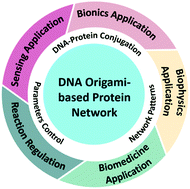DNA origami-based protein networks: from basic construction to emerging applications
Abstract
Natural living systems are driven by delicate protein networks whose functions are precisely controlled by many parameters, such as number, distance, orientation, and position. Focusing on regulation rather than just imitation, the construction of artificial protein networks is important in many research areas, including biomedicine, synthetic biology and chemical biology. DNA origami, sophisticated nanostructures with rational design, can offer predictable, programmable, and addressable scaffolds for protein assembly with nanometer precision. Recently, many interdisciplinary efforts have achieved the precise construction of DNA origami-based protein networks, and their emerging application in many areas. To inspire more fantastic research and applications, herein we highlight the applicability and potentiality of DNA origami-based protein networks. After a brief introduction to the development and features of DNA origami, some important factors for the precise construction of DNA origami-based protein networks are discussed, including protein–DNA conjugation methods, networks with different patterns and the controllable parameters in the networks. The discussion then focuses on the emerging application of DNA origami-based protein networks in several areas, including enzymatic reaction regulation, sensing, bionics, biophysics, and biomedicine. Finally, current challenges and opportunities in this research field are discussed.



 Please wait while we load your content...
Please wait while we load your content...